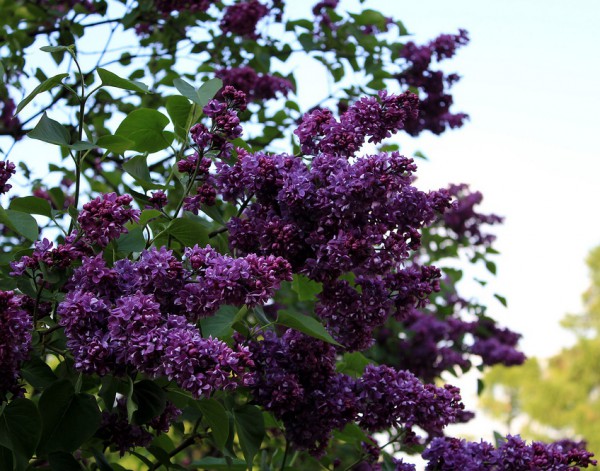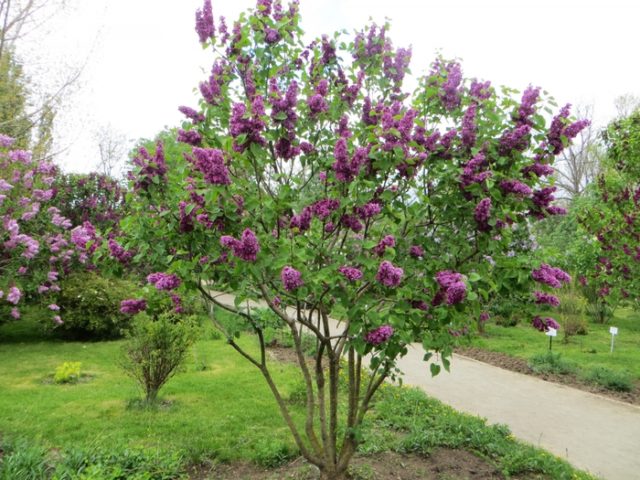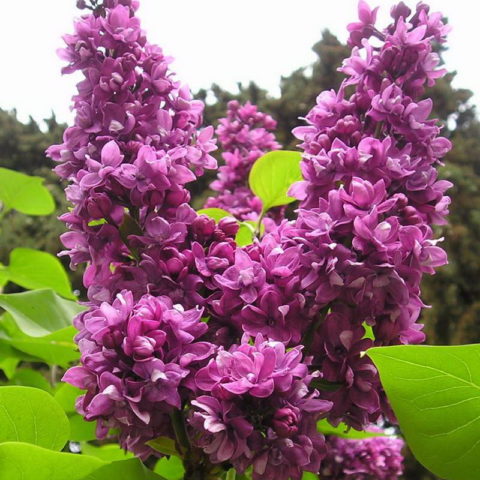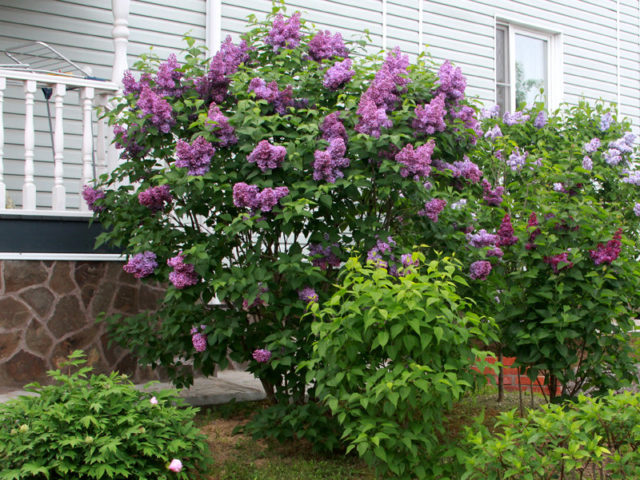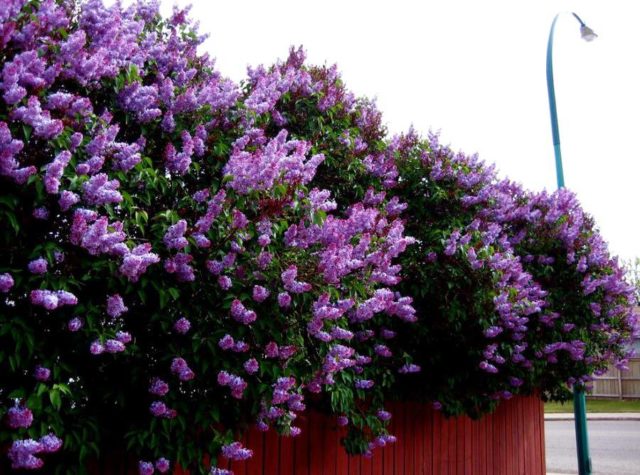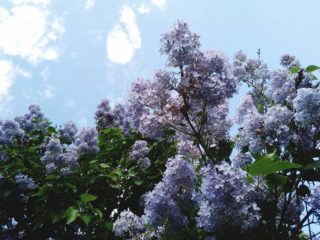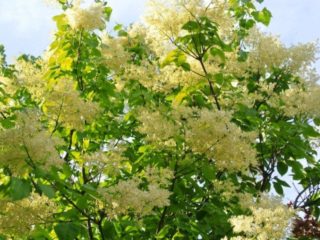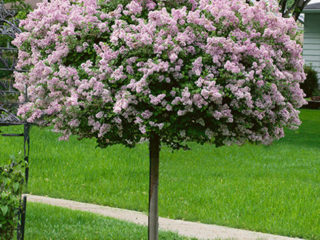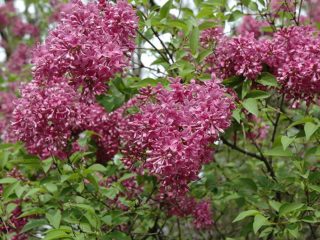Content
Lilac Fires of Donbass are included in the group of magenta ones, with luxurious reddish-lilac blooms. The terry variety was bred in 1956. 20 years later, at an exhibition in Czechoslovakia, he received a silver medal.
Description of lilac Lights of Donbass
Ornamental shrub Ogni Donbassa grows from 2 to 3.5 m, is formed with a spreading crown on one trunk or from several trunks. The root system is well developed, located superficially. Many shoots break through near the central shoot. The bark of the shrubs is grayish, smooth in young shoots. On old trunks, from 5 cm in diameter, with long longitudinal cracks. Shoots branch densely, creating a rounded, dense crown, the diameter of which is from 1 m at a young age to 2 m and more in a 10-year-old plant. Lilac bush Lights of Donbass lends itself well to pruning.
In spring, leaf and flower buds swell early. Leaves bloom with warm weather, do not fall until frost. Due to the beautiful, heart-shaped form of opposite leaves and the rich color of dark greenery, lilac is decorative throughout the summer-autumn season. The length of the leaf blade is up to 8-10 cm, the width is 4-6 cm, the apex is pointed.
Variety Lights of Donbass, bred on the basis of common lilac:
- unpretentious;
- drought-resistant;
- winter hardy, withstands frosts down to -40 ° C.
The plant takes root and develops in all regions of the middle lane.
How lilacs bloom Lights of Donbass
Photo of lilacs The Lights of Donbass conveys the luxurious flowering of reddish-purple bunches, which bloom in medium terms, usually in May. Inflorescences are formed from two paired pyramidal panicles and separate lower branches. The density of the blossoming buds is average. The length of the panicle is from 15 to 20 cm, the width is 9-10 cm. The buds of a lush variety of lilac are large, in diameter equal to the size of a pea.
The purple-lilac flowers of the Donbass Lights variety gardeners refer to the Magenta group, which includes varieties of lilacs with reddish petals. A double flower is large, 2-3 cm wide, consists of 2-3 corollas. The doubleness of the lilac visually increases due to the fact that the tops of the oval petals rise from the plane of the rim. The peculiarity of the Donbass Ogni variety is the lighter tops of the petals, which, against the general carmine-lilac background of the blossoming brush, create a fascinating impression of flickering lights. The authors gave the new lilac variety a name associated with the blinking of miner's lamps in the face. The intense color of the petals of the Donbass Lights is resistant to fading; it remains for a long time even in the solar exposition. Bunches of lilacs emit an intense, delicate aroma.
The flowering of the Donbass Ogni variety is long, until autumn seeds are formed in bivalve capsules.
Breeding features
In nurseries, lilacs are propagated by seeds. Growing enthusiasts exchange new plants using shoots, cuttings, cuttings or grafting methods. Lilac bushes grown from cuttings and cuttings constantly retain their characteristics. Layers are added in early spring and care for the shoots, watering and loosening the soil. Young plants are transplanted in the fall or next summer. Lilac cuttings root poorly.It is necessary to choose for this purpose only young shoots during the period when the bush has faded.
Plants on a wild lilac rootstock without proper care can lose the trunk with a scion in the abundance of shoots extending from the root. Therefore, when buying a variety of Donbass Lights, they are sure to be interested in how to obtain a seedling.
Planting and caring for lilacs Lights of Donbass
An unpretentious variety requires minimal maintenance.
Recommended timing
Although most varieties based on common lilac are unassuming to care for, plants require attention when planting. Unlike other crops, ornamental hardy bushes are planted in the second half of summer - from mid-July to early September.
Site selection and soil preparation
Lilac Lights of Donbass shows the full potential of decorativeness in an open, illuminated place. Light partial shade is also allowed. Bushes thrive on fertile soils with weak or neutral acidity. Lilac is resistant to dry periods, but prefers regions with moderate to heavy rainfall.
How to plant correctly
Placing several ornamental bushes next to each other, the holes are dug every 2 m. For planting, seedlings are chosen:
- with fresh, well-developed roots;
- no damage to the trunk;
- with healthy leaves.
On poor soil, spacious pits are prepared for laying, together with garden soil, 15 kg of humus, 200 g of wood ash, 60 g of superphosphate. The place of the scion should be above the ground. After compacting the soil around the trunk, a bucket of water is poured out. In the steppe regions, the soil is mulched to keep moisture longer.
Growing lilacs Lights of Donbass
An ornamental plant will retain its attractiveness with regular, competent pruning.
Watering
Lilacs are supported by watering in spring and June. On moist soil, the plant develops better and blooms more luxuriantly. From the second half of summer, the bush is also watered once a week in the absence of rain. Each plant consumes 20-60 liters of water, which depends on its volume.
Top dressing
In the spring, the variety `` Lights of Donbass '' is fed with nitrogen fertilizers of your choice:
- 50 g of urea;
- 80 g of ammonium nitrate;
- a bucket of a diluted 1: 5 mullein, which is poured into a groove dug along the perimeter of the root system.
After 2-3 years, at the end of September, beginning of October, potassium-phosphorus preparations are introduced under the lilac bush in a dry form, scattering the granules into the grooves:
- 35 g of potassium nitrate;
- 60 g superphosphate.
Then the perimeter of the trunk circle is watered abundantly.
In summer, lilacs are fed with a solution of 0.5 liters of wood ash in a bucket of water. Such support is especially useful in an area with acidic soil.
Mulching
Near the seedling, the soil is regularly loosened so that a crust does not form after watering. Remove all weeds. After planting, the trunk circle is mulched with bark, old sawdust, dry grass or humus. In the fall, the mulch layer is renewed, adding new material.
Pruning
According to reviews, the lilac Lights of Donbass blooms especially magnificently the next year after cutting the inflorescences, up to 60%. The panicles are cut after the wilted buds wither. Formative and sanitary pruning of lilacs is carried out in the spring, before the start of sap flow:
- begin to give the desired silhouette to the seedling from the third year of development;
- 5-7 branches are left on the central trunk;
- next spring, pruning is carried out on these skeletal branches so that 7-8 buds remain on them;
- a plant that is not overloaded with flowering develops better;
- then every year, thickening and wind-damaged or frost-damaged branches, root shoots are removed.
Preparing for winter
The Ogni Donbass variety tolerates severe frosts if there is enough snow. Young bushes are mulched with peat, leaves, humus - a layer of up to 12 cm. In snowless winters, the trunks are covered with burlap.
Diseases and pests
Lilacs can be infected with fungal and bacterial diseases:
- verticellosis;
- powdery mildew;
- bacterial necrosis and rot.
Treatment with copper oxychloride, fungicides is effective. For the prevention of diseases:
- when pruning, the crown is thinned as much as possible;
- in spring, lilacs are treated with preparations containing copper;
- in the fall, the leaves are harvested and burned if signs of illness were visible.
Leaf-gnawing pests, like the lilac hawk moth and the lilac moth, are destroyed with insecticides. The lilac mite damages the kidneys, they get rid of it by digging up the trunk circle in early spring and prophylactic spraying.
Conclusion
Lilac Lights of Donbass, an unpretentious frost-resistant plant, will give the spring garden a festive look. For lush flowering, the bush requires infrequent watering, traditional dressing in spring and autumn, and regular pruning.
